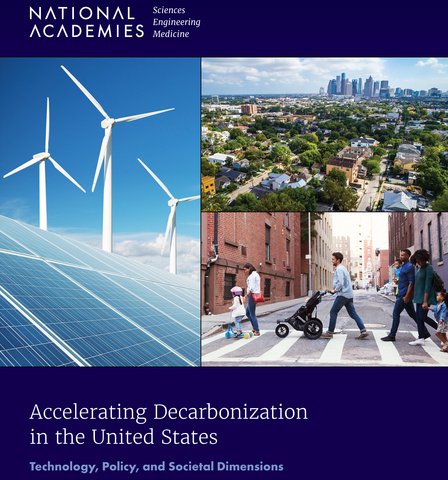Jenny Bratburd and Jonathan Patz Led Chapter on Public Health Co-Benefits for National Academies Report
New National Academies Report on Accelerating Decarbonization Includes Health Chapter
Article Author: Michael Kamp, MS
Nelson Institute for Environmental Studies
Overview
With a background in microbiology, Climate Solutions for Health Lab (CSFHL) member Jenny Bratburd brings a unique perspective to the team. Bratburd, a writer and researcher for the lab, has a PhD in microbiology but has pivoted towards climate and health research, including focusing on air quality with Professor Tracey Holloway. “During my PhD, I became really interested in science policy and how science influences the way we make decisions as a society, and climate change and public health are two of the pressing issues of our time,” Bratburd said.
The PhD gave Bratburd experience problem solving and breaking down complex systems with many interacting parts. That analytical approach has aided Bratburd’s climate and health research, and she has written for multiple reports, such as the 2023 National Academies report on decarbonization.
The current fossil fuel system to generate energy (e.g., coal, oil, gas) is contributing to climate change, so the United States is amid an energy transition with the goal of reaching net-zero fossil fuel emissions by 2050. Bratburd said, “The big question is how we decarbonize quickly, or how do we get rid of all the fossil fuel that’s embedded in all the different systems, sectors in the U.S.”
The National Academies of Sciences, Engineering, and Medicine (NASEM), a non-partisan organization of experts that compile scientific evidence for policy making, released a report in 2021 on decarbonization. The 2021 report outlined steps on reaching net-zero across different sectors, like electricity generation, buildings, and industry, but did not include other considerations of reaching net-zero. “One of the things that was missing from the first report was what are the impacts on health,” Bratburd said.
Clearly, as the CSFHL studies day-to-day, climate change affects public health. Decarbonizing, or moving away from carbon-based sources of energy to renewable sources of energy, has many health benefits. A key health benefit of burning fewer fossil fuels is an improvement in air quality.
Air Quality Health Benefit
Burning less fossil fuels helps improve air quality.
“If we stop burning fossil fuels, like coal for instance, we’re going to have a lot less air pollution. Burning fossil fuels not only emits greenhouse gases, but it also emits particulate matter and contributes to other types of air pollution, like nitrous oxides (NOx) and sulfur dioxide (SO2) that are very bad for our health,” Bratburd said. Ambient air pollution is among the top environmental risk factors for premature death.
“A lot of great scientists have quantified those benefits, and we call them co-benefits…. not only do we reduce greenhouse gases, but we also clean up pollution,” Bratburd said. The co-benefits of climate change mitigation are a fundamental area of research for the CSFHL.
Besides air quality benefits, there are other health benefits to climate change mitigation, like the physical fitness benefits of switching from driving to walking or biking. Transferring away from fossil fuels, like natural gas from fracking, can protect water quality. Increasing urban greenspace can reduce temperatures during heatwaves as well as store carbon. In short, there are many pathways that climate change affects public health.
Equity is another very important consideration when thinking about climate change mitigation, and equity is intertwined with public health. For example, many harmful, polluting facilities have been built next to communities with the fewest resources to fight back. Redlining is another example of the linkage between public health and equity. “We have this history of justifying infrastructure needs that sometimes comes at a cost to different groups of people and their wellbeing and has consequences that continue on for a long time, which is what those redlining figures (see below) often show… you can look at examples of old policies that have since become illegal, but the ramifications are still there,” Bratburd said.
Tree cover (left) and summer temperature (right) in Richmond, VA.
Source: The New York Times, 2020. How Decades of Racist Housing Policy Left Neighborhoods Sweltering.
The Decarbonization Report
Released in fall 2023, the report on decarbonization by NASEM , Accelerating Decarbonization in the United States: Technology, Policy, and Societal Dimensions, still focuses on the technological aspects of climate change mitigation, but additionally considers a more holistic view of decarbonization. The new report also examines the necessity of clear communication surrounding climate change. Numerous experts across the country contributed to the 13-chapter report on differing aspects of decarbonization.
Bratburd and Jonathan Patz, a member of the National Academies of Medicine and head of the CSFHL, directed the health chapter for the report. The chapter focuses on air quality, energy access, diet, physical fitness, water quality, greenspace, and transportation. Despite many co-benefits of climate change mitigation, the chapter also considers potential problems, such as the mining of minerals for batteries and solar panels. Bratburd said, “We want to maximize the health benefits and avoid problems, thinking about these new technologies and how we can source them sustainably.”
An overwhelming feeling of where to start can be common while facing the reality of climate change. Consequently, in this report, there are over 80 specific recommendations on how to decarbonize with specific actions outlined for specific actors. There are health-relevant recommendations throughout the report in sector-specific chapters, but three detailed recommendations are in the health chapter, the third chapter of the report.
Recommendation 3-1 calls on Congress and the U.S. Department of Agriculture to phase out incentives of the highest greenhouse gas emitting animal protein sources, like beef. Recommendation 3-2 advocates to grow the use of health impact assessment tools for energy projects so the costs and benefits for public health can be understood. Finally, Recommendation 3-3 suggests clearly assessing the occupational health risks associated with clean energy technologies, such as manufacturing, installation, and disposal.
Looking Ahead
Bratburd is excited to see the conversation on how health will be affected brought into the decarbonization report. “When we talk about introducing these new technologies or having people take them up, I think how it affects my health is a major question for individuals and for communities that needs to be addressed,” Bratburd said.
When asked about what the report will accomplish at its ideal, Bratburd had a quick response, “Hopefully people will decarbonize.” Bratburd acknowledged that there will not be a one-size-fits-all solution for every sector, but the report summarizes many different solutions for consideration.
Climate change cannot be ignored, and the decarbonization report plainly outlines the urgency of the climate crisis. “The stakes are high for climate change in this country, but the report makes it clear there are a lot of benefits to climate action, and this is a big opportunity. There are a lot of specific benefits and specific actions outlined in the report to make it easier to figure out the next steps,” Bratburd said. The chapter on health led by Bratburd and Patz contributes a piece to the climate change mitigation equation, and the whole report outlines how the United States can reach its net-zero goal in a healthy and equitable manner.



